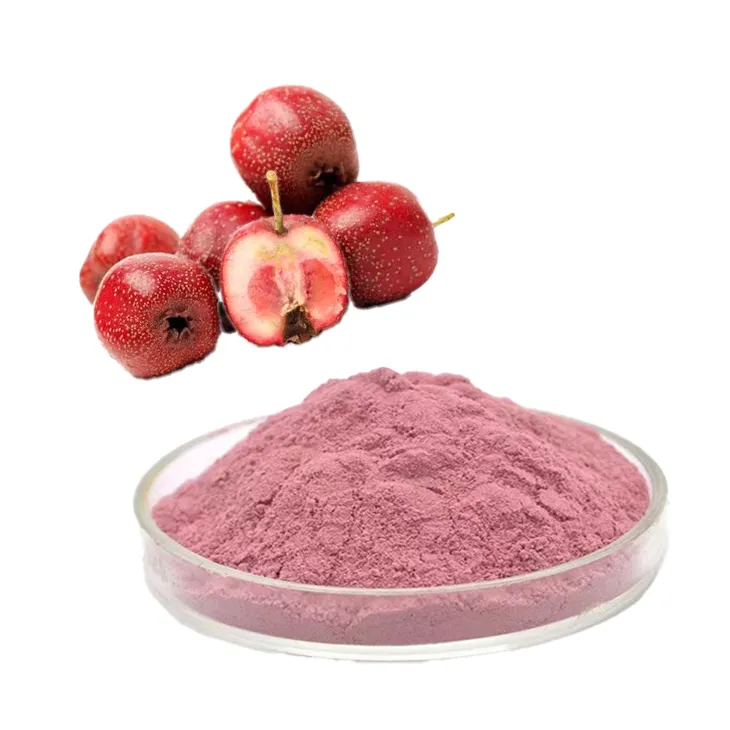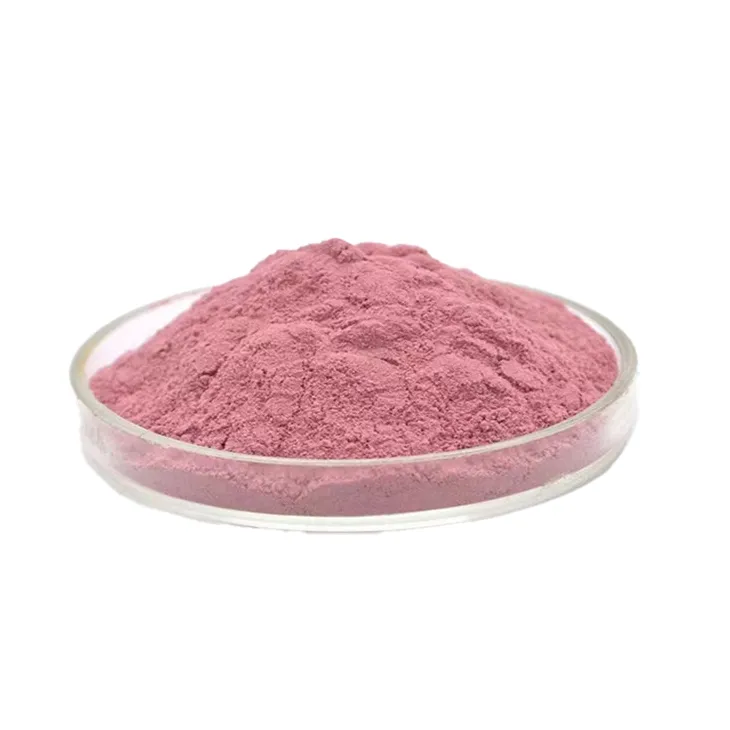- 0086-571-85302990
- sales@greenskybio.com
The process of extracting chlorogenic acid from hawthorn powder.
2024-11-28

1. Introduction
Hawthorn powder is a valuable source of various bioactive compounds, among which chlorogenic acid stands out due to its numerous potential applications in medicine and food industries. Chlorogenic acid is known for its antioxidant, anti - inflammatory, and antimicrobial properties. The extraction process of chlorogenic acid from Hawthorn powder is of great significance as it allows for the isolation and utilization of this valuable compound.

2. Hawthorn powder as the Starting Material
Hawthorn, a well - known plant, is rich in a variety of substances. When processed into powder, it becomes a convenient starting point for the extraction of chlorogenic acid. The quality of the hawthorn powder plays a crucial role in the extraction process. Factors such as the origin of the hawthorn, the method of powder production, and its storage conditions can all affect the content and extractability of chlorogenic acid within it.

3. Selection of Extraction Solvents
3.1 Properties of Ideal Solvents
The selection of appropriate extraction solvents is the first and vital step in the extraction of chlorogenic acid from hawthorn powder. Ideal solvents should have certain properties. They need to be able to effectively dissolve chlorogenic acid while minimizing the dissolution of unwanted impurities. Moreover, they should be relatively safe, easy to handle, and cost - effective.3.2 Common Solvent Mixtures
A common choice is a mixture of ethanol and water. Ethanol is a polar solvent, and when combined with water, it can create an environment that is conducive to the dissolution of chlorogenic acid. The ratio of ethanol to water can vary depending on the specific characteristics of the hawthorn powder and the extraction conditions. For example, a ratio of 70:30 (ethanol: water) is often used in many extraction processes. This ratio can strike a balance between the solubility of chlorogenic acid and the selectivity against other components in the hawthorn powder.
4. Extraction Techniques
4.1 Soxhlet Extraction
- Soxhlet extraction is a traditional and widely used method. It involves continuously refluxing the solvent through the hawthorn powder sample. The hawthorn powder is placed in a thimble inside the Soxhlet apparatus, and the solvent is heated and vaporized in the flask at the bottom. The vapor rises, condenses in the condenser, and then drips back onto the hawthorn powder, gradually extracting the chlorogenic acid.
- This method has the advantage of being relatively simple and can handle a relatively large amount of sample. However, it is time - consuming, usually taking several hours to complete an extraction cycle. Also, it may require a relatively large amount of solvent.
4.2 Ultrasonic - Assisted Extraction
- Ultrasonic - assisted extraction is a more modern and efficient technique. In this method, ultrasonic waves are applied to the mixture of hawthorn powder and solvent. The ultrasonic waves create cavitation bubbles in the solvent, which implode and generate high - pressure and high - temperature micro - environments. These micro - environments can enhance the mass transfer process, allowing the chlorogenic acid to be more effectively separated from the hawthorn powder.
- Compared to Soxhlet extraction, ultrasonic - assisted extraction is much faster, often reducing the extraction time from hours to minutes. It also requires less solvent, which is more environmentally friendly. However, the equipment for ultrasonic - assisted extraction is relatively more expensive.

5. Purification Steps
5.1 Importance of Purification
After the extraction process, the obtained extract contains not only chlorogenic acid but also other components from the hawthorn powder. Purification is crucial to obtain highly pure chlorogenic acid for further applications. Impurities in the extract can interfere with the performance and quality of the chlorogenic acid in various applications, such as in medicine where purity is of utmost importance.5.2 Chromatographic Methods
- High - performance liquid chromatography (HPLC) is one of the most effective chromatographic methods for purifying chlorogenic acid. In HPLC, the extract is injected into a column filled with a stationary phase. A mobile phase, usually a solvent or a mixture of solvents, is then pumped through the column at a controlled flow rate. The different components in the extract, including chlorogenic acid, interact differently with the stationary and mobile phases, resulting in their separation.
- The conditions for HPLC, such as the type of column, the composition of the mobile phase, and the flow rate, need to be optimized according to the specific characteristics of the extract. By carefully adjusting these parameters, highly pure chlorogenic acid can be obtained at the end of the chromatographic process.
6. Applications of Chlorogenic Acid
6.1 In the Medical Field
- Chlorogenic acid has shown potential in various medical applications. Its antioxidant properties can help in reducing oxidative stress in the body, which is associated with many chronic diseases such as cancer, cardiovascular diseases, and neurodegenerative diseases. For example, it may scavenge free radicals and prevent the damage of cells and tissues.
- It also has anti - inflammatory effects. Inflammatory processes are involved in many diseases, and chlorogenic acid can modulate the inflammatory response by inhibiting certain inflammatory mediators. This makes it a potential candidate for the treatment of inflammatory - related diseases such as arthritis.
6.2 In the Food Industry
- In the food industry, chlorogenic acid can be used as a natural antioxidant. It can prevent the oxidation of fats and oils in food products, thereby extending their shelf life. This is especially important for processed foods that are prone to rancidity.
- It can also contribute to the flavor and color of food products. Some studies have shown that chlorogenic acid can interact with other food components to produce unique flavor and color profiles, which can enhance the overall quality of food.
7. Conclusion
The process of extracting chlorogenic acid from hawthorn powder involves multiple steps, from the selection of appropriate solvents to the application of extraction techniques and finally purification methods. Each step is crucial for obtaining high - quality and pure chlorogenic acid. The isolated chlorogenic acid has significant potential applications in both the medical and food fields. As research continues, more efficient and cost - effective extraction and purification methods may be developed, further expanding the utilization of chlorogenic acid from hawthorn powder.
FAQ:
Question 1: Why is a mixture of ethanol and water often used as the extraction solvent?
Chlorogenic acid is a polar compound. A mixture of ethanol and water, which are polar solvents, can effectively dissolve chlorogenic acid. Ethanol has good solubility for many organic compounds, and water is a common and inexpensive polar solvent. The combination of the two can enhance the extraction efficiency of chlorogenic acid from hawthorn powder.
Question 2: What are the advantages of Soxhlet extraction in this process?
Soxhlet extraction is a continuous extraction method. It can repeatedly extract the sample with fresh solvent, ensuring that chlorogenic acid in hawthorn powder is fully dissolved and extracted. It is suitable for the extraction of compounds with relatively stable properties and has a relatively high extraction efficiency for chlorogenic acid in this case.
Question 3: How does ultrasonic - assisted extraction work for chlorogenic acid extraction?
Ultrasonic - assisted extraction uses ultrasonic waves to create cavitation effects in the solvent. These cavitation bubbles collapse, generating local high - temperature and high - pressure environments, which can break the cell walls of hawthorn powder more effectively. This helps to release chlorogenic acid into the solvent more easily, thus increasing the extraction rate compared to traditional extraction methods.
Question 4: Why is purification necessary after extraction?
After extraction, the obtained extract contains not only chlorogenic acid but also other components from hawthorn powder. Purification is essential to remove these impurities and obtain highly pure chlorogenic acid. Only highly pure chlorogenic acid can be used for accurate research, in medicine, and for food applications where purity requirements are high.
Question 5: What are the key factors affecting the extraction efficiency of chlorogenic acid from hawthorn powder?
The key factors include the type and ratio of the extraction solvent, the extraction method (such as Soxhlet extraction or ultrasonic - assisted extraction), extraction time, temperature, and the particle size of hawthorn powder. The proper selection and control of these factors can significantly affect the extraction efficiency of chlorogenic acid.
Related literature
- Extraction and Characterization of Chlorogenic Acid from Hawthorn: A Review"
- "Optimization of Chlorogenic Acid Extraction from Hawthorn Powder Using Response Surface Methodology"
- "The Role of Chlorogenic Acid in Hawthorn and Its Potential Health Benefits"
- ▶ Hesperidin
- ▶ citrus bioflavonoids
- ▶ plant extract
- ▶ lycopene
- ▶ Diosmin
- ▶ Grape seed extract
- ▶ Sea buckthorn Juice Powder
- ▶ Beetroot powder
- ▶ Hops Extract
- ▶ Artichoke Extract
- ▶ Reishi mushroom extract
- ▶ Astaxanthin
- ▶ Green Tea Extract
- ▶ Curcumin Extract
- ▶ Horse Chestnut Extract
- ▶ Other Problems
- ▶ Boswellia Serrata Extract
- ▶ Resveratrol Extract
- ▶ Marigold Extract
- ▶ Grape Leaf Extract
- ▶ blog3
- ▶ blog4
- ▶ blog5
-
The best lemon juice powder in nature.
2024-11-28
-
Organic Vitamin K2 Powder Suppliers
2024-11-28
-
Bulk purchase of L - tyrosine.
2024-11-28
-
Vitamin K2 Manufacturers
2024-11-28
-
100% Pure Natural Rutin.
2024-11-28
-
Chinese Citrus Bioflavonoid Suppliers.
2024-11-28
-
Golden Seal Extract
2024-11-28
-
Acerola Juice Powder
2024-11-28
-
Epimedium extract powder
2024-11-28
-
Elderberry Extract
2024-11-28
-
Jujube Extract
2024-11-28
-
Medicinal Marshmallow Extract
2024-11-28
-
Diosmin
2024-11-28
-
Centella Asiatica Extract
2024-11-28
-
Sea buckthorn oil
2024-11-28
-
Baicalin
2024-11-28





















